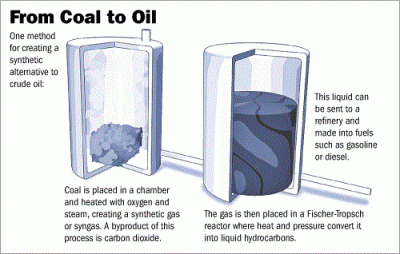
In South Africa, where coal is plentiful and cheap, a process has been pioneered by the Sasol Company to convert coal into oil.
Coal is loaded into large containers, set alight, and blasted for several minutes with a mixture of steam and oxygen under high pressure. The coal burns and produces large amounts of gas which is rich in hydrogen and carbon – the basic building blocks from which oil can be made.
As oil contains about twice as many hydrogen atoms as coal, extra hydrogen has to be added to the coal gas. It is provided by the steam. The burning coal generates enough energy to separate the water molecules in the steam into hydrogen and oxygen atoms. The hydrogen produced gives the gas the right balance of hydrogen and carbon.
This gas must be ‘washed’ with methanol to remove sulphur and cyanides. Then it is transferred to reactors where further chemical treatment determines the final product. The reactors can produce petrol, oil, waxes, liquefied petroleum gas and chemicals such as alcohols, aldehydes and ketones.
It is an expensive process, justified in South Africa by the very low price of coal and the fear of an oil embargo.
Picture Credit : Google




